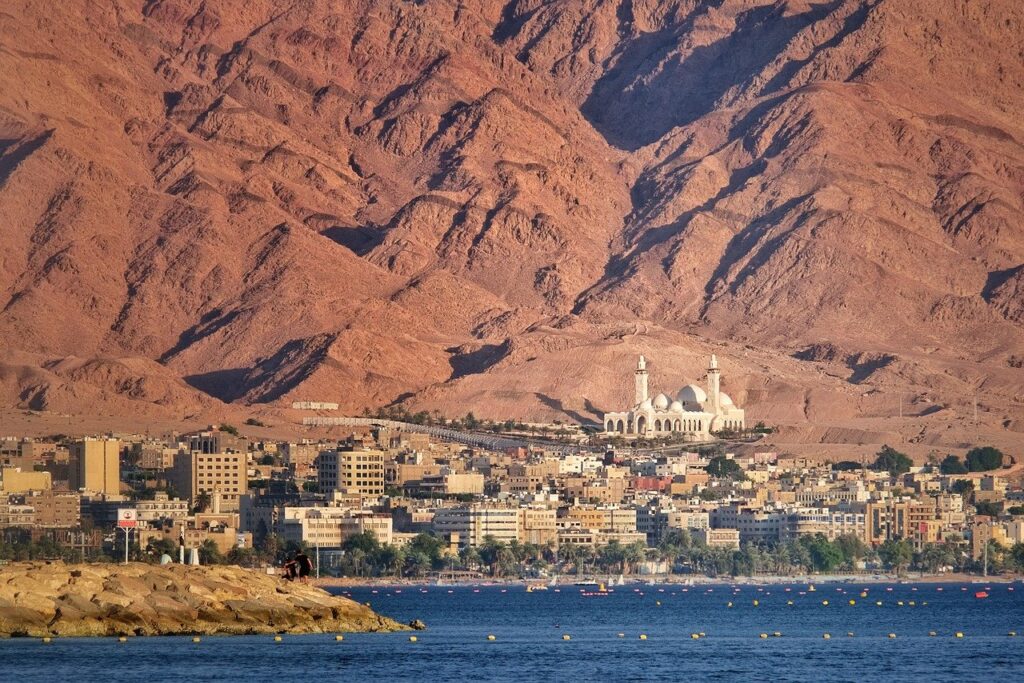
Planning to visit Eilat during your stay in Israel and wondering what to do in this vibrant city? You’ve come to the right place! This detailed travel guide will help you discover everything you need to know about Eilat: from the best things to do and explore in the city and its surroundings, to the perfect places to stay, where to eat, and some useful tips and recommendations to make the most of your trip.
Ready to dive into the wonders of Eilat? Let’s go!
Table of Contents
What to do in Eilat and around :
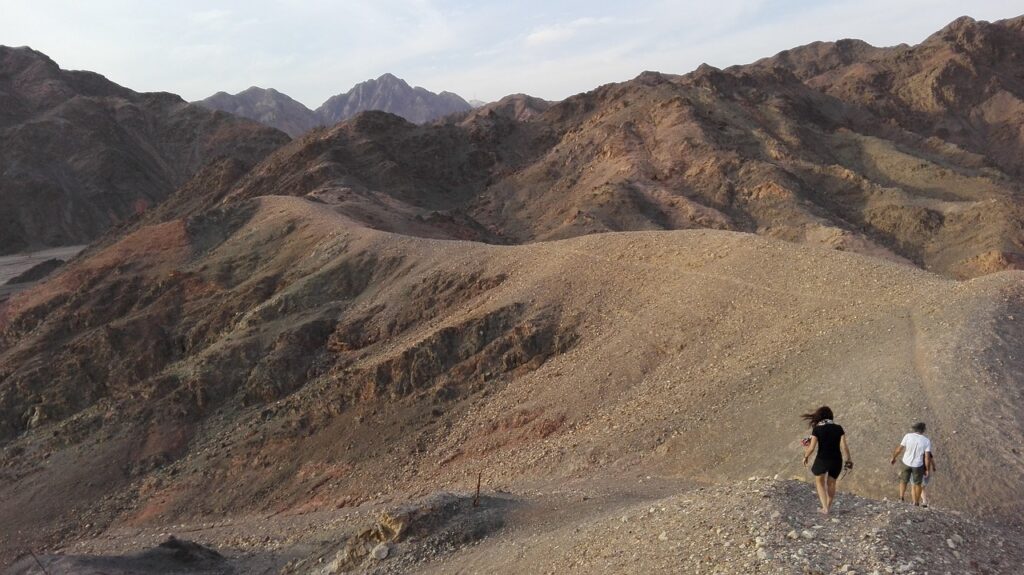
- Eilat, a small yet captivating city in Israel, is perfectly situated on the shores of the Red Sea. It’s only a few kilometers from the Jordanian border (3 km to the east) and the Egyptian border (8 km to the west).
- While it may look like a typical seaside resort, what sets Eilat apart is its consistently excellent weather, making it an ideal destination for swimming year-round.
- And just beyond the city lies the breathtaking Negev Desert, offering stunning landscapes and adventure.
- If you’re wondering what to do in Eilat and its surroundings, worry not—there’s truly something for everyone! For those who just want to relax, sunbathe, and enjoy the beach, Eilat is a perfect fit. But if you’re more into nature and hiking, you’re in luck—the nearby mountains and desert provide ample opportunities for exploration and adventure.
> Enjoy the Red Sea in Eilat:
The Red Sea is the number 1 attraction for tourism in Eilat. Here are all the options it offers.
>> Swimming on one of Eilat’s beaches

- Eilat has developed all along the Israeli coast on the Red Sea. The seaside town therefore has many beaches to offer tourists. Most are well-equipped, with deckchairs and access to the sea so as not to damage your feet. There are also many bars right next door, which have placed plenty of “beach lounges”.
- Basically, in Eilat, you can spend a whole day sipping cocktails, sunbathing, and taking a dip in the Red Sea, in calm and warm water, all without having to walk more than 10 meters: pretty cool if you come to Eilat to rest and relax.
- A small precaution though: bring sunscreen (maximum SPF), and avoid exposing yourself during the hottest hours of the day.
>> Snorkeling around Eilat
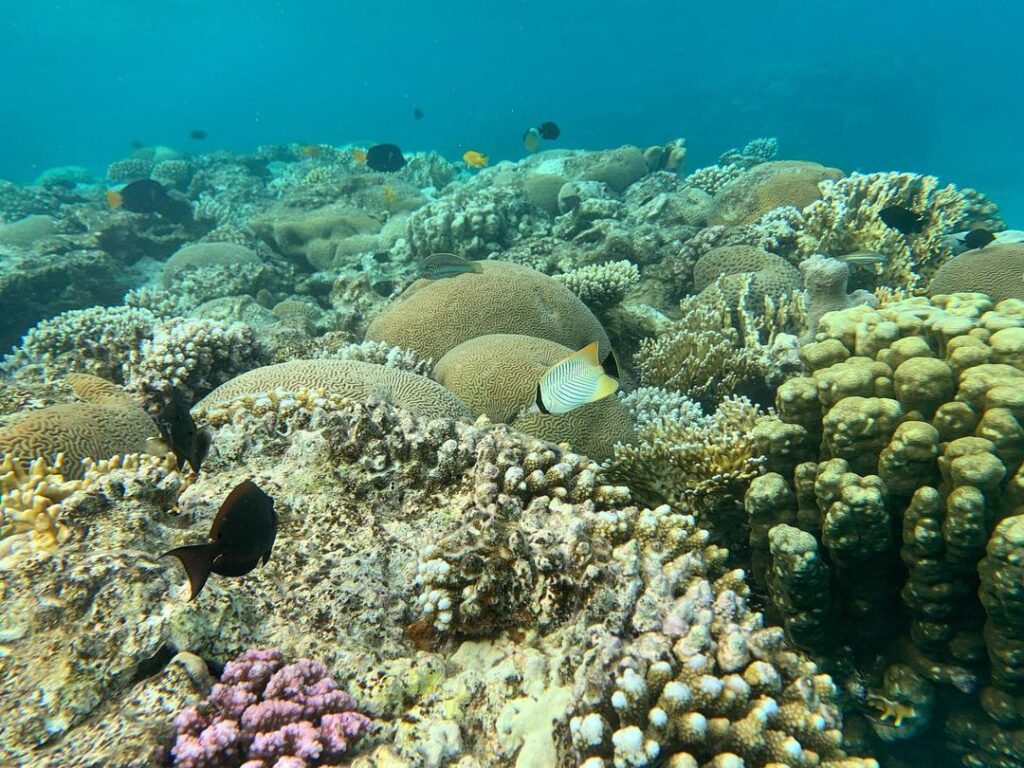
- All you need is a mask and snorkel, and you’re ready to explore a stunning underwater world just a little west of Eilat, heading toward the Egyptian border. The Red Sea’s translucent waters reveal a breathtaking array of colorful fish swimming right past you, and beautiful coral formations glisten below. It’s an incredible sight that’s impossible to grow tired of!
- The Red Sea is renowned for its vibrant underwater life, and Eilat is one of the best spots to experience it. Even if snorkeling isn’t your usual activity, I highly recommend trying it for an hour or two—you’ll be amazed at what you’ll see, and you won’t regret it!
- For the best snorkeling experience, head to Coral Beach Nature Reserve, southwest of Eilat’s center, near the Egyptian border. This is a protected area, so there’s a small entrance fee (26 shekels, around €7). But if you’d rather not pay, just before the Reserve is Almog Beach, where you can see almost the same marine beauty for free, though it’s usually more crowded.
- To reach Coral Beach Nature Reserve, take bus number 15 towards Egypt. If you’re in central Eilat, hop on at the “Ha’arava Road/Yotam Road” stop behind the shopping center. Get off at “Mitsrayim Road / Field School.” The ticket costs about 4 shekels (roughly one euro), and the ride takes about 15 minutes, sometimes longer depending on traffic. For Almog Beach, get off at the stop right before the Reserve: “Mitsrayim Road / Almog Beach.” To return, take bus 16 back to the city.
- You can rent snorkeling gear from the many diving clubs between Almog Beach and Coral Beach Nature Reserve—plenty of options, and prices and services are generally the same across the board.
>> Scuba Diving in Eilat
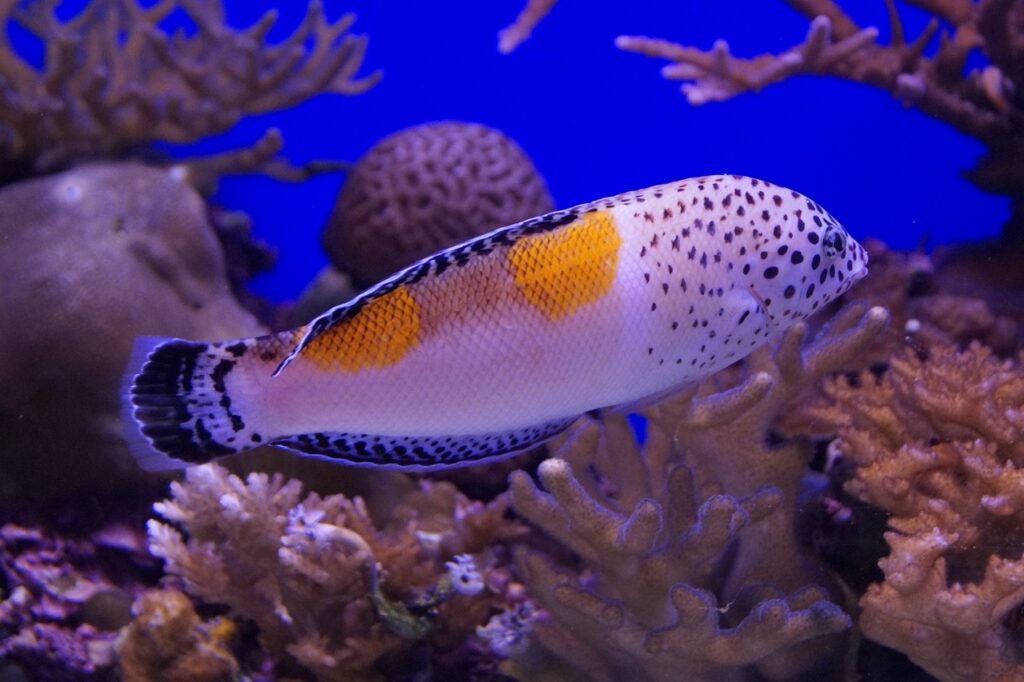
Photo credit: Elche74 / Tripadvisor
- If you’re into snorkeling and want to take things up a notch, diving in the Red Sea in Eilat is an incredible experience you shouldn’t miss. The underwater world here is rich and full of surprises. For instance, you can dive into the wreck of a French military ship that was sunk in 1994, explore the remains of an underwater restaurant now covered in coral, or even visit an artificial pyramid where colorful fish have made their home. Expect to see rays, turtles, and a variety of fish in all shapes and sizes—a true diver’s paradise!
- One of the best things about diving in Eilat is that most dive spots are easily accessible from the shore—no need for a boat ride! This is great news for experienced divers who want to jump right in. The best dive spots are concentrated around Coral Beach, so it’s a top recommendation for anyone looking to dive in the area.
- Diving clubs are plentiful along the shores of Eilat, and Marina Divers is one that consistently receives praise for its professional staff. If you’re using public transport, just hop on bus 15 (heading towards Egypt) and get off at the Almog Beach stop.
- Keep in mind that there’s an entrance fee of 26 shekels (about €7) for the Coral Beach Nature Reserve, but if you want to dive for free, just head further north to Almog Beach!
>> Observe the underwater fauna in the Underwater Observatory Park
Photo credit: CoralWorld.co.il
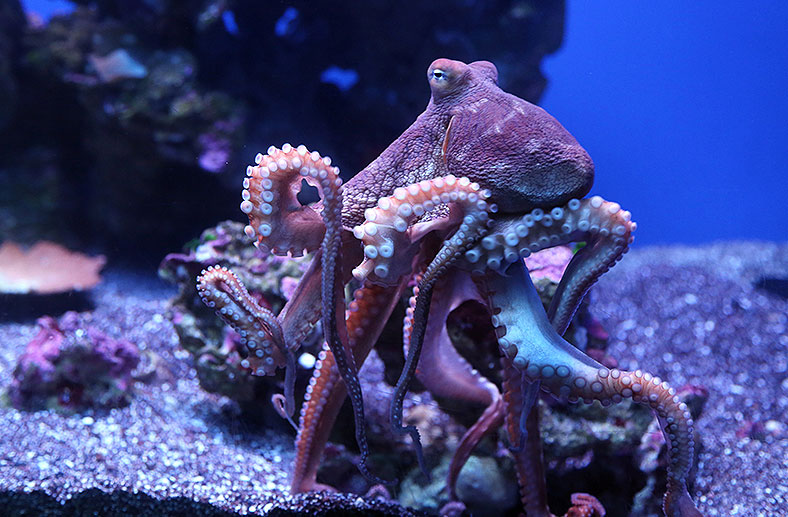
- If you’re not keen on diving into the water during your stay in Eilat but still want to experience marine life, you can visit the Underwater Observatory Park. Though the facilities might feel a bit old-fashioned, the marine life is truly impressive—sea turtles, sharks, rays, colorful fish, and vibrant corals make it a visual treat!
- There are also specific times that are more exciting to visit, especially if you want to watch the sharks being fed. The feeding happens twice a day at 11:30 am and 3:00 pm, but it’s a popular event, so make sure to arrive a bit early to grab a good viewing spot. Sea turtles are fed at 12:30 pm, and the “regular” fish get their meals at 11 am, all in their respective aquariums.
- On the practical side, you can purchase your tickets in advance from the official website. The price for a standard adult ticket is 125 shekels (about €30), and there’s a small discount if you book online. Tickets for children are 105 shekels (€25). While there’s an “Oceanarium” option, it’s not necessary unless you’re really into learning about ocean life. The basic ticket should suffice for those just wanting to see the animals.
- To get there from central Eilat, it’s a bit too far to walk, especially if you’re with kids. Instead, take bus 15, which heads towards Egypt, and get off at the Mitsrayim Road/Underwater Observatory stop. Tickets cost 6 shekels and can be bought from the driver. Buses run every 20 minutes. For your return, take bus 16, which follows the same route back to the city. It’s a similar route as many other attractions around Eilat!
>> Swimming with dolphins in Eilat

Photo credit: Dolphinreef.co.il
- Do you dream of swimming with dolphins at least once in your life? Great news: you can make that dream come true during your visit to Eilat! Though it’s a bit pricey (290 shekels, around €70 per person), it’s a unique and unforgettable experience that would be hard to pass up. The downside, however, is that the place can feel a bit commercial—they don’t allow you to take your own photos, so you have to buy theirs.
- On the bright side, they also have a lovely private beach, which is quieter compared to the central beaches in Eilat. There’s even a spot where you can grab something to eat.
- To get there, simply take bus number 15—the same one that goes to the Observatory and the beaches—and get off at the Dolfin Reef stop. The dolphin area entrance is right across the road.
- For more details on ticket purchases and opening hours, you can check out their website.
> What to do around Eilat if you love nature
The city of Eilat is the largest seaside resort in Israel, and at first glance, you might think that it is a place made only for those who like to lounge on the beach, down mojitos, and listen to trendy music. But Eilat has much more to offer than that: the exceptional nature that surrounds the Israeli city offers many possibilities for those of you who prefer to spend an active holiday. Here are some suggestions to fill your stay there if you love nature.
>> Explore the Red Canyon
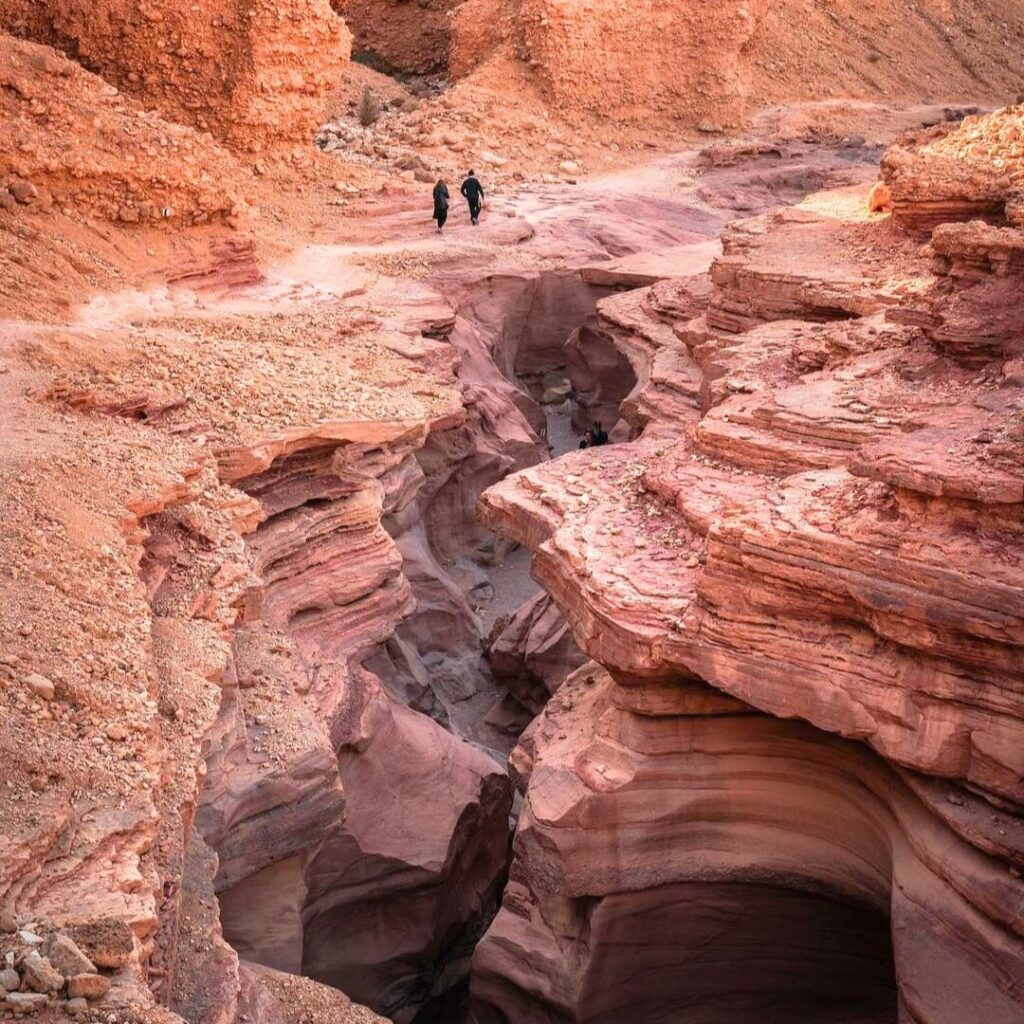
- If you love nature, the Red Canyon is the must-see spot near Eilat (and really during any trip to southern Israel). While it’s a popular tourist destination, it’s absolutely worth the visit. This unique geological formation offers a short hike through a canyon with stunning colors that resemble those found in Arizona or Colorado.
- While locals in Eilat may describe it as an easy hike, I beg to differ. There are parts where you’ll need to climb the canyon walls, whether you’re going uphill or downhill, depending on your direction. If you’re young and fit, it’s not too complicated, but for older visitors or anyone with limited mobility, it might be tough to complete the entire trail.
- On the practical side, bus 392 takes you from Eilat’s central station to the entrance of the Red Canyon. The trip costs 25 shekels (pay the driver) and takes about 30 minutes. Don’t worry about missing the stop—90% of the bus will get off there with you, and the driver usually announces it in English (most other stops in the desert are military bases). However, keep in mind that bus 392 is a mainline route to Beer Sheva, and there are only about 5-6 buses a day, so be sure to plan your trip carefully.
- For the return journey, you’ll need to catch the same bus 392 on the other side of the road. Unfortunately, the bus times aren’t posted at the stop, so you’ll need to check the schedule at the Eilat bus station before you leave. Worst case scenario, hitchhiking is a common and safe option in Israel (I’ve done it myself a few times), but be aware that cars might be scarce later in the day or during Shabbat.
Photo credit: SummitPost.org
>> Climb Mount Har Cfachot and admire the view
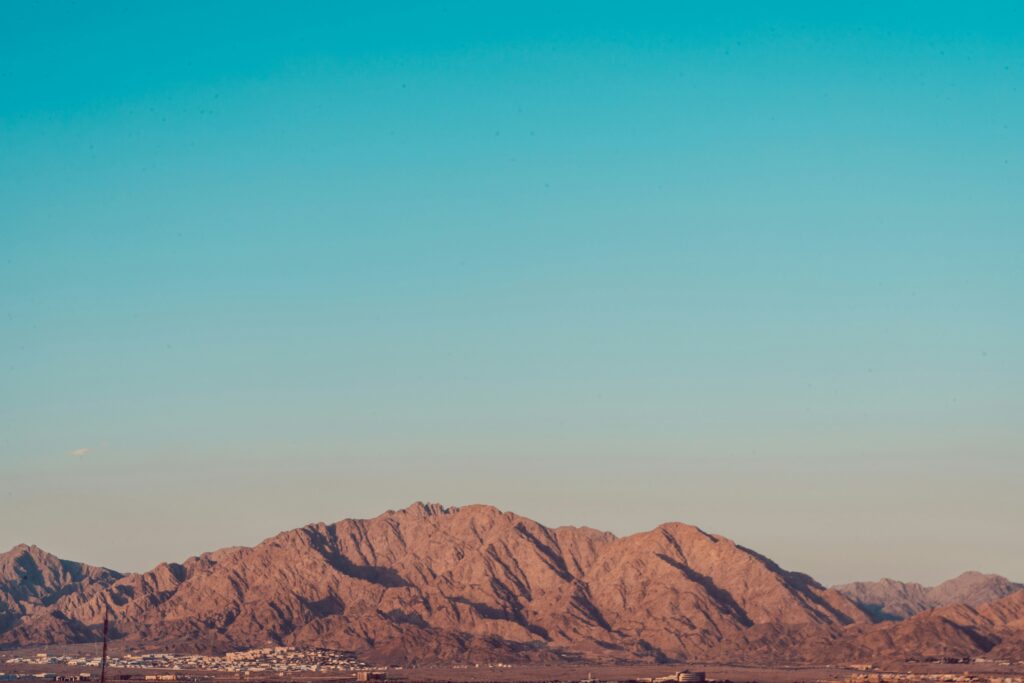
- This hike is fairly popular and not too challenging, taking about 1.5 to 2 hours of walking, especially if you take your time to admire the views along the way. Once you reach the top of Mount Har Cfachot (at 272 meters above sea level—not the highest peak, but high enough for an impressive panorama), you’ll be treated to a breathtaking view of four countries: Jordan, Egypt, Saudi Arabia, and of course, Israel. Some suggest staying until sunset, but I recommend starting your descent while it’s still light out to avoid navigating in the dark, unless you’re equipped with a flashlight.
- For the hike’s practical details, the trail starts at the Eilat Field School. You’ll find it along Road 90, which leads to Egypt, just before you reach the Underwater Observatory. If you don’t have a car, the easiest way to get there is by taking bus number 15 and getting off at the Mitsrayim Road/Field School stop. Be aware that the signage at the beginning isn’t great (just a small sign in Hebrew on the roadside, with a blue arrow and a dromedary). If you’re unsure, it’s best to ask for directions to the trailhead when you arrive. Once you find the trail, simply follow the green markings to the viewpoint at the top.
- A complete loop is even possible to return via the Camel Ranch (then go back down to Route 90 and take the bus back to town).
>> Hiking around Eilat on the Israel National Trail
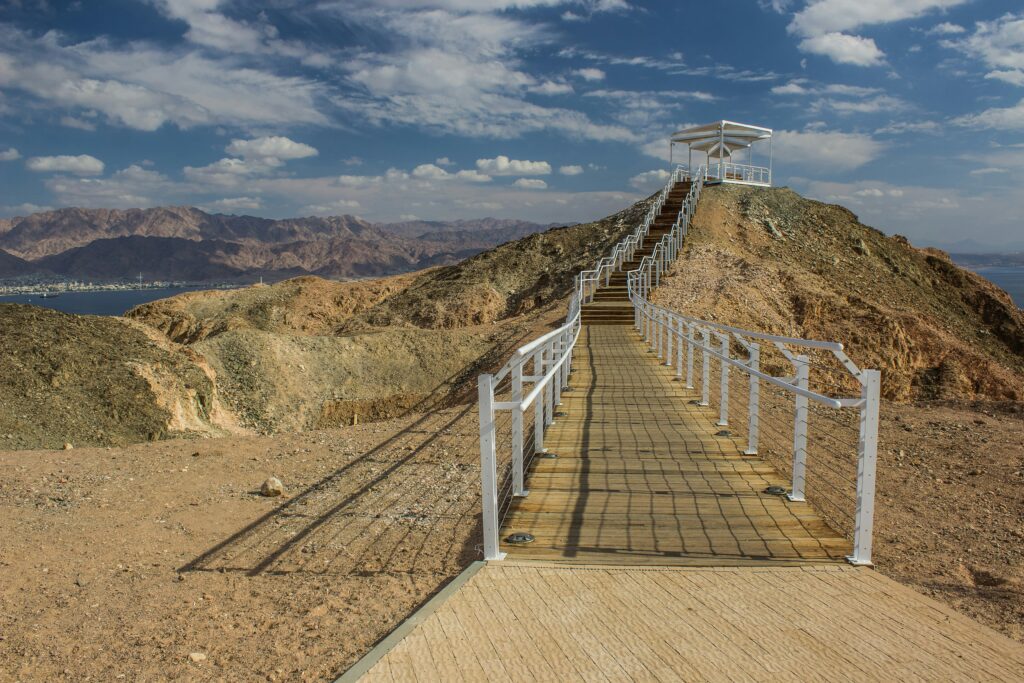
- Eilat is the city where the Israel National Trail either begins or ends, depending on your direction. This is a long-distance trail stretching over 1,100 kilometers, from Kibbutz Dan near the Lebanese border all the way down to the Red Sea at Eilat, passing through stunning landscapes along the way.
- Of course, you likely won’t hike the entire route during your stay, but if you’re into hiking, I highly recommend doing a part of it. The sections accessible from Eilat are particularly beautiful, offering amazing views of the Red Sea, the desert, and the mountains—with glimpses of Jordan, Egypt, and even Saudi Arabia in the distance, if the weather’s clear.
- For example, I followed the trail to the point where it intersects with Road 12, close to the Egyptian border, heading north. To start, head to the dolphin roundabout at the northern exit of Eilat (where Road 12 begins), walk up Road 12 for a few hundred meters, and then turn right when you see brown signs for Wadi Roded and Wadi Netafim. Follow the small road for 200 meters, and you’ll see the hiking trail starting on the right (look for the white-black-white trail markers on a lamppost).
- From there, you’ll follow a path that leads to a crossroads where four wide paths meet. Continue following the white-black-white markings, which will guide you along the Israel National Trail into the Eilat Nature Reserve. The trail is marked by the reserve’s damaged sign.
- You can walk straight as long as you like, or turn left when you reach a blue trail marker (you’ll see a small, solitary tree on the left). This is where I recommend going for stunning views of the desert, mountains, Eilat, and Jordan.
- The path narrows and climbs through a small canyon, becoming steeper towards the top. Your efforts will be rewarded with a platform view by an electric pylon. If you want, you can continue along the ridge for even more panoramic sights, though I turned back at this point.
- Once back at the intersection of the blue and main trails, you can also take the main trail left for a few minutes to another area, where you’ll find mountain bikers and a picnic table with an Israeli flag, offering more stunning views.
- Taking your time, this entire hike lasts around four hours, depending on how long you linger at viewpoints and your hiking pace.
Tip: Use the online Israel hiking map (though it’s all in Hebrew) along with Google Maps and Google Translate to help you navigate.
>> Mountain biking
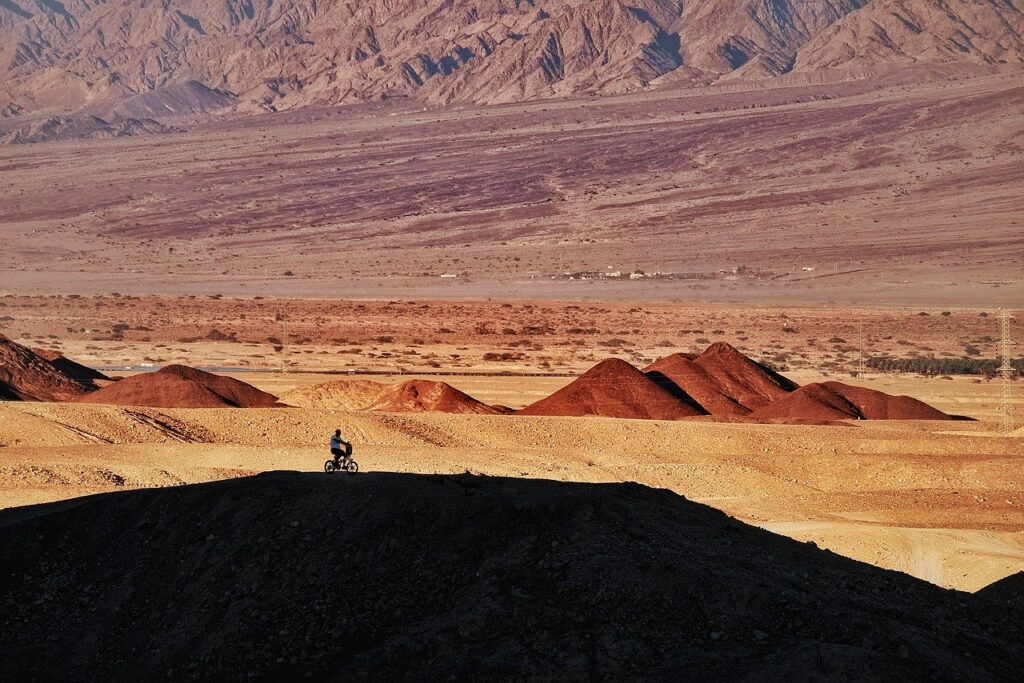
- If you’re into mountain biking, the Eilat Mountains offer dedicated trails, complete with signage. To access one of the most popular trails, follow the same route I mentioned earlier for hiking, but instead of turning left onto the blue trail, continue a bit further and turn right when you see the mountain bike trail markers. This area offers stunning views and is perfect for biking enthusiasts.
>> Explore the desert on camelback
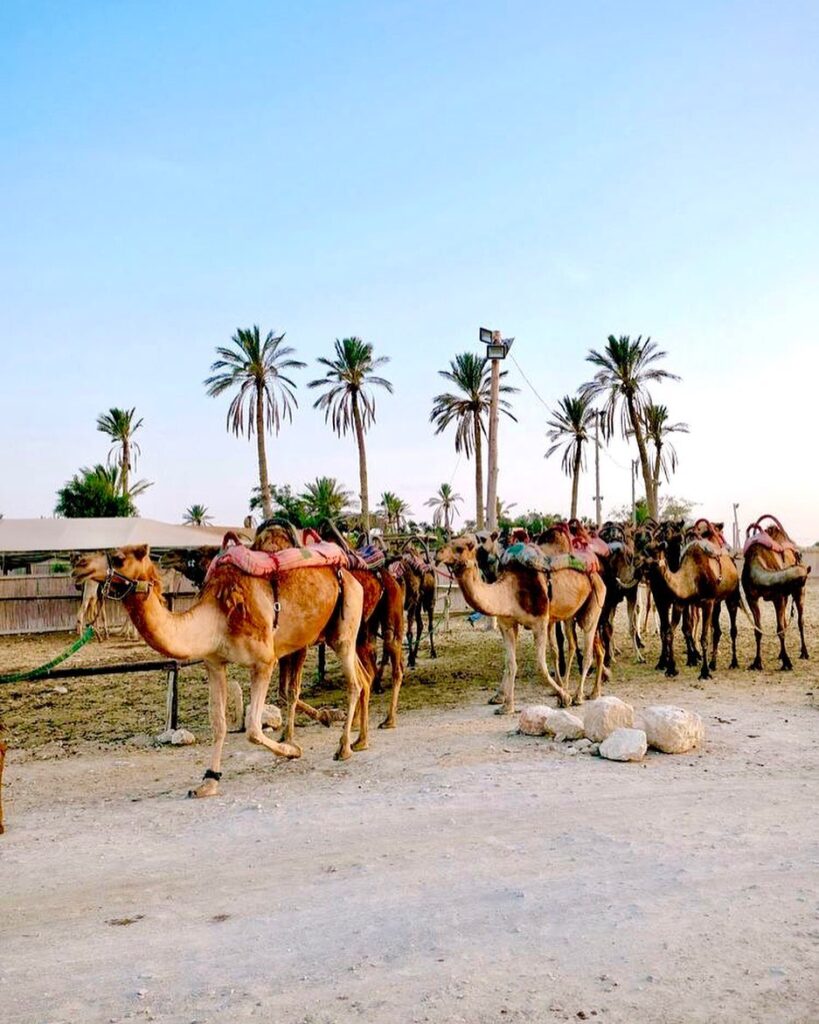
If hiking isn’t your thing or you’re in the mood for a unique desert adventure, then a visit to Camel Ranch for a camel ride might be just what you’re looking for!
They offer a variety of outings:
- Short rides lasting 10 minutes, perfect for kids or first-timers. However, you’ll stay near the ranch and won’t explore much of the desert. This option costs around 60 shekels (€15) for 10 minutes, which might feel a bit pricey for such a brief experience.
- 1.5-hour camel treks take you deeper into the Eilat desert for 180 shekels per adult. It’s a nice balance between time and experience.
- For a full adventure, consider the 4-hour trek for 290 shekels (€80), where you’ll truly appreciate the desert’s beauty with views of remote areas.
Pro Tip: It’s recommended to buy your tickets a day or two in advance since spots fill up quickly, and the schedule can vary depending on the weather. However, tickets are only available up to a week before your visit.
To get there:
- There’s a free shuttle service from the center of Eilat for guests.
- Alternatively, take bus 15 and get off at the “Camel Ranch” stop. From there, it’s about a 1 km walk to the ranch, following signs leading toward the mountains.
For more details or to book your tickets, check out their website (available in English, Hebrew, or Russian). Enjoy your desert adventure!
>> Explore the desert by jeep
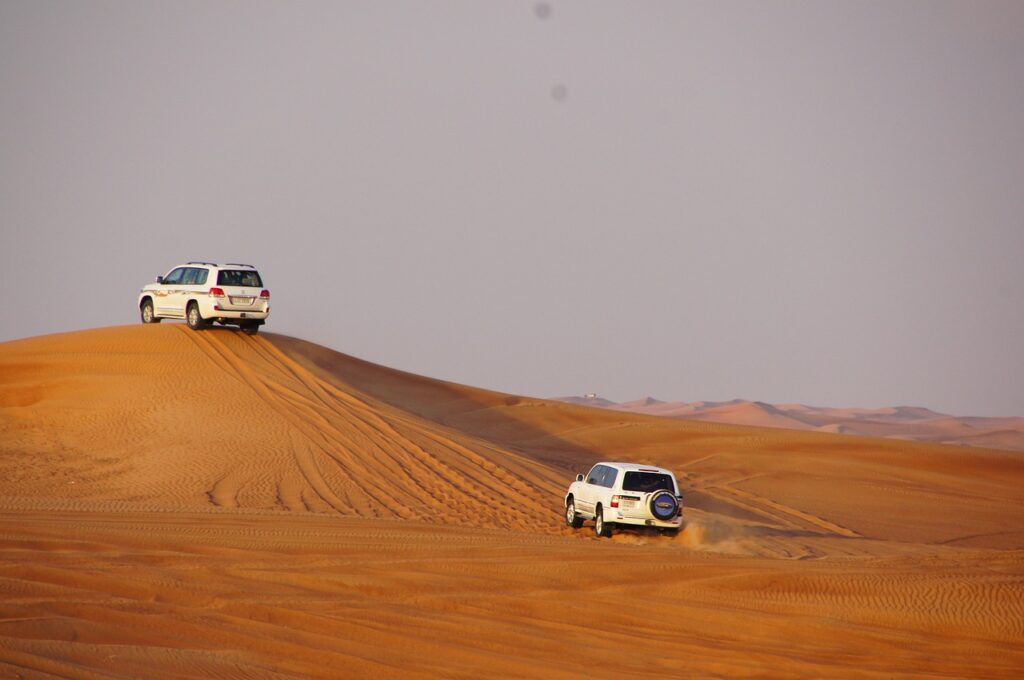
- If you’re looking for a less eco-friendly but adventurous way to explore the desert, jeep tours are a fantastic option! Unlike a camel trek, a jeep allows you to venture deeper into the desert, reaching truly remote spots for an even more thrilling and unique experience.
- One exciting option is a night tour, where you can observe nocturnal wildlife like jackals, hyenas, and more.
- The company offering these tours is Desert Eco Tours. They provide a variety of outings, including day trips and nighttime desert explorations. You can find more information about their tours and book on their website.
> Other things to do in southern Israel near Eilat
If you still have time and energy, here are some suggestions for things to do easily from Eilat and in southern Israel during your stay there.
>> See Timna Park and its geological curiosities
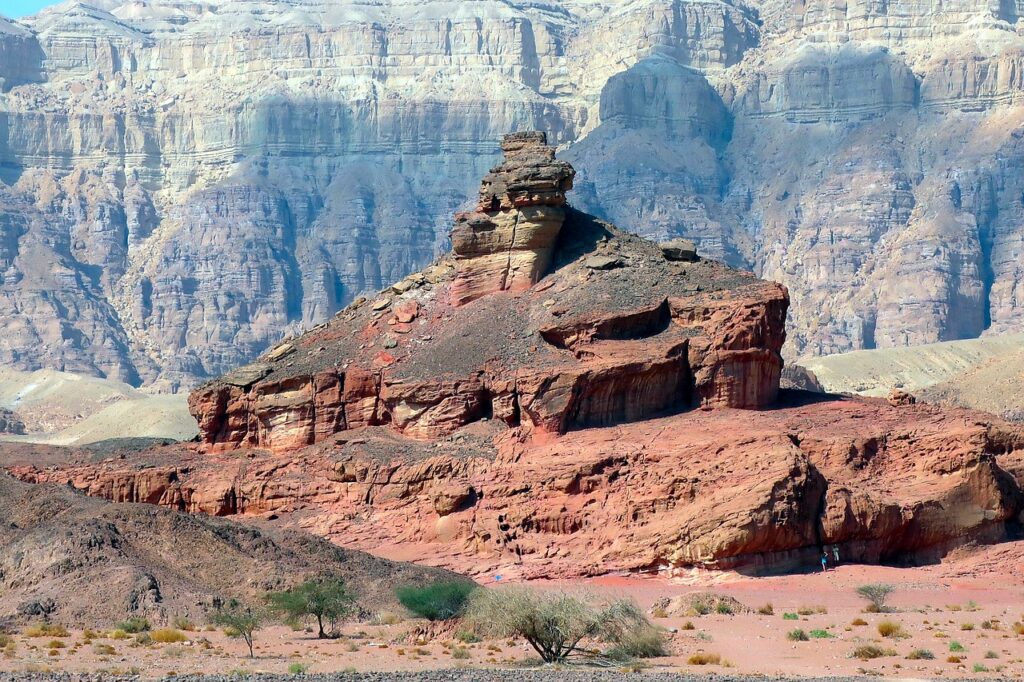
Photo credit: parktimna.co.il
- Timna Park, located 25 km north of Eilat, is a stunning nature reserve perfect for a day trip or even a half-day adventure. However, it’s most convenient if you have your own vehicle, as buses drop passengers several kilometers from the park’s entrance on Route 90. While it’s possible to get there via public transport, you’ll need to walk quite a bit or try hitchhiking.
- Inside the park, you’ll discover 25 hiking and walking trails, each offering spectacular views of geological formations like the “Mushroom,” the “Arches,” and “Solomon’s Pillars.” These natural rock formations, with their eccentric shapes, make for an amazing outdoor experience.
- In short, Timna Park is a desert oasis with plenty of hiking options for all skill levels, offering a perfect way to explore the desert’s diverse and unique landscapes.
Practical Info: You can visit the official Timna Park website, available in English, and purchase your entrance ticket for 49 shekels (about €14). They also offer a shuttle service from Eilat for an extra 90 shekels per person (€25), but at that price, renting a car might be a better option!
>> Visit the Yotvata Hai-Bar Natural Reserve

- Just two kilometers north of Timna Park, you’ll come across the Yotvata Hai-Bar Nature Reserve. This reserve is known for gathering all the animals mentioned in the Bible. However, while it sounds intriguing, it’s worth noting that it might not live up to the hype. The entry fee is 32 shekels (€9), and there’s not much to see—a small safari with few visible animals and landscapes that are less impressive compared to other desert spots.
>> Bathing in the Dead Sea
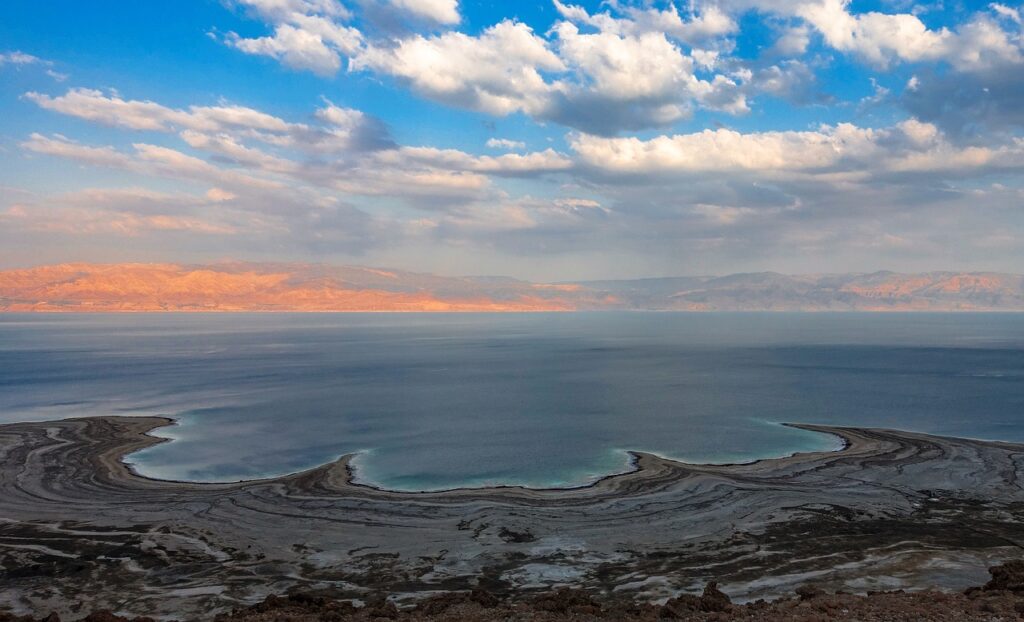
Swimming in the Dead Sea is an absolute must during any trip to Israel. Even though I went in torrential rain (rare for this region), I couldn’t miss the chance to experience the world’s unique floating sensation. Trust me, it’s something you have to try! You don’t swim so much as float effortlessly in the dense, mineral-rich waters.
To get there, you’ve got a few options:
- On your way from Jerusalem: You can stop at Ein Gedi or Ein Bokek for a dip in the Dead Sea and continue to Eilat afterward. If you’re driving, it’s straightforward. If taking the bus, hop on line 444, and get off at the Oasis Hotel stop in Ein Bokek, right in front of the public beach (most Dead Sea beaches are private and linked to luxury hotels). Then, you can catch the bus again to continue your journey. Make sure to check the timetables, so you don’t miss the last bus.
- From Eilat: You can do a round trip using bus 444. It departs from the bus station heading toward Jerusalem and returns back to Eilat. The ride costs about 45 shekels (€11) for each direction and takes 2h45 one way (about 6 hours round trip).
- Private Tour: If you’ve got a higher budget and don’t want to waste time on public transport, you can arrange a private trip by car through a tour organization. Renting a car is another good option—this way, you can travel on your own schedule without depending on buses or tours.
Important: Whether you’re taking the bus or booking a tour, make sure to reserve your spot in advance. The route to the Dead Sea is always busy, and last-minute plans won’t work well—plan a few days ahead to guarantee your spot!
> Visit Petra from Eilat:

Photo credit: Azurfrog / Wikimedia Commons
- Are you planning to visit Petra from Eilat? Good news—it’s totally doable! Exploring the ancient wonder from the Israeli seaside resort is simple, as long as you’ve got some time on your hands.
- The easiest and most hassle-free way is to join an organized group tour that is familiar with the process of crossing the Israeli-Jordanian border. Going alone can be tricky for several reasons. First off, you can’t drive into Jordan with a car rented in Israel, and there is no public transportation that runs between Aqaba (the closest Jordanian city) and Petra.
- For your Petra visit from Eilat, I recommend leaving early in the morning with a tour group that takes care of everything, including the border crossing. The tour will pick you up from your accommodation, help you cross the border, and bring you directly to Petra, where you’ll have free time (guided tours are available if you prefer). After your time in Petra, you’ll head back to Eilat in the evening.
- Keep in mind, though, that it’s a long day: Petra is 150 km from Eilat, and the border crossing can sometimes take a while. In total, you’ll spend about 4.5 hours on the road (round trip), plus time at the border.
- If you want to really enjoy Petra, I suggest opting for a two-day trip instead of a single day. This gives you more time to soak in the ancient beauty without feeling rushed. You’ll spend the night in Petra, and if you wake up early the next morning, you’ll have the entire ancient city to yourself, bathed in the soft morning light—an incredible and unforgettable experience.
>Where to stay in Eilat
>>If you want to enjoy the Red Sea:

For those primarily visiting Eilat to enjoy the Red Sea, staying near the western beaches (towards Egypt) is your best option. This area is quieter than the city center, and you’ll have access to the best, least crowded beaches. Plus, you’ll be near all the main attractions like the Underwater Observatory, Dolphin Reef, and top snorkeling and diving spots.
- Recommended Accommodation: Stay here for the perfect seaside location with stunning views. Alternatively, if you prefer to stay in the city but want easy beach access, this place offers just that.
>>If you want to enjoy the mountains:

For those like me, who want to enjoy both the mountains and the sea, look for accommodation halfway between the two. However, keep in mind the distance—it can be about a 20-minute walk to the beaches and mountains. This area is quieter, and the rates are more affordable, but it’s better suited for those who don’t mind walking or cycling.
- For A Great Mountain & Sea Access: If you have a higher budget, stay closer to Egypt, near the Eilat Field School hiking trails and Coral Beach Reserve. Check out this spot for the best of both worlds.
>>If you want to enjoy the city’s entertainment:
Eilat, like Tel Aviv, is known for its nightlife. The beachfront is where all the action happens, with beach bars and DJs keeping the energy alive until the early morning. If you’re keen to stay close to the party scene, there are plenty of accommodation options nearby.
- Top Picks: For a splurge, stay here, or if you’re on a budget, try this option that won’t break the bank.
>>If you want to stay away from hustle and bustle, but in the city:
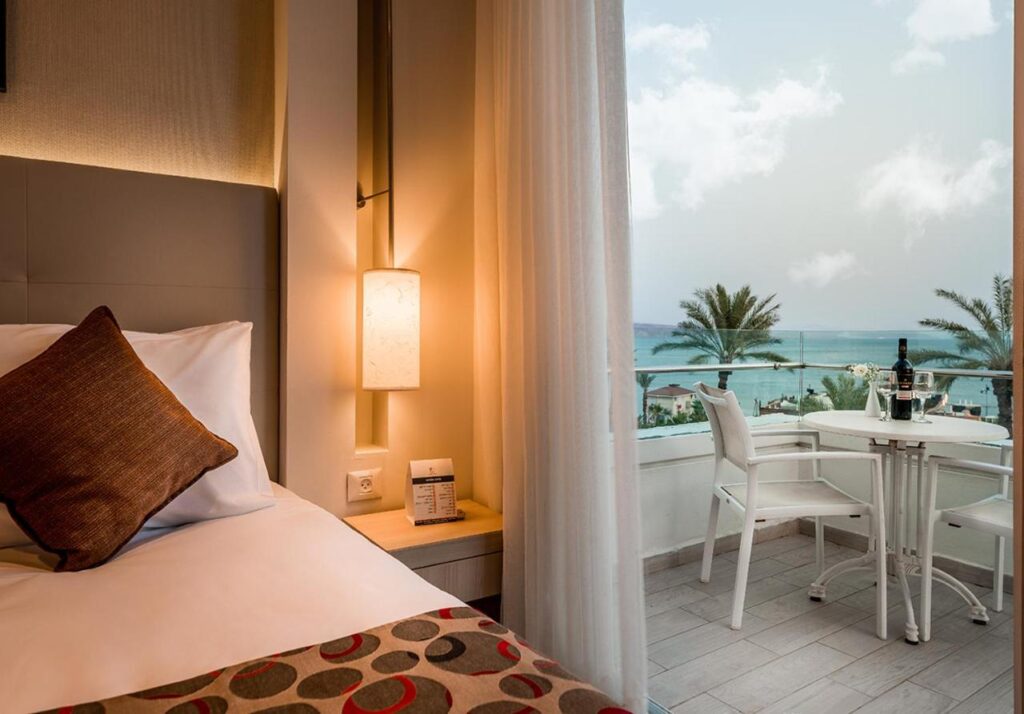
If you’re looking for a quiet retreat but still want to be within walking distance of the beach and the city’s amenities, I recommend staying in a residential area just outside the city center. It’s peaceful, yet close enough to everything.
- Best Option: Check out this guesthouse, which features a great pool—a perfect place to relax when the sun gets too hot.
>Going out in Eilat: eating and drinking
Below are my suggestions for restaurants and bars in Eilat .
>>Where to Eat in Eilat

- For those into burgers and pizzas, you’ll find tons of options along the promenade that stretches by the sea. It’s hard to miss, as it’s packed with casual eateries.
- One downside of Eilat is that there are few standout places to eat. But don’t worry—you’ll find plenty of spots to grab falafel, hummus, and other quick bites all over the city.
- However, if you’re looking for somewhere to sit down and enjoy a quiet meal, it gets trickier. One spot worth mentioning is Les Sardines at HaMayim 3, which is known for its great seafood.
>>Where to Have a Drink in Eilat

- When night falls, make your way to Three Monkeys along the promenade. It’s a cozy pub with big screens for sports and a great place to relax with a beer. If you’re lucky, you’ll catch some live music and even hit the dance floor.
- For those who want to party until late, one spot comes highly recommended: Selena Club at Carmel 8. The venue is known for its DJs and is buzzing with both locals and tourists.
How to get to Eilat
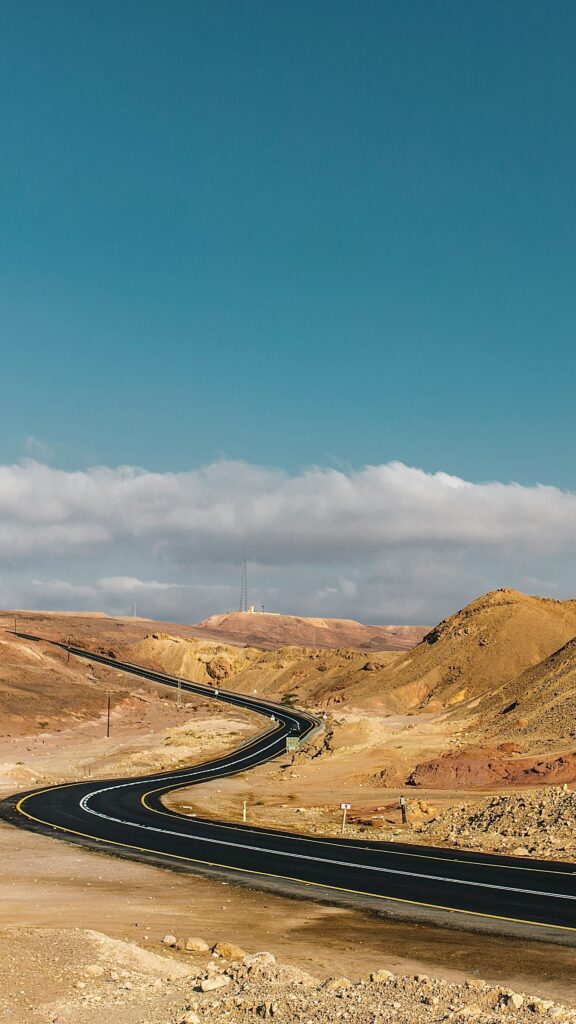
Eilat is the southernmost city in Israel . Here’s how to get there.
> From Tel Aviv
There is no rail connection to Eilat (the Israeli train system doesn’t extend further south than Beersheba), but you can easily travel from Tel Aviv to Eilat by bus or internal flight.
>>By Bus:
- You can take bus 390 or 394 from the Tel Aviv bus station, which is located right next to the Ha’Hagana train station (108 Levinsky Blvd). The bus trip costs 70 shekels (€17) and takes between 5 and 6 hours. Check the Egged website for schedules, as Egged operates the majority of Israel’s transportation.
- There’s also an option to change buses in Beersheba (a city at the northern edge of the Negev desert), but it’s much easier to take a direct line since it doesn’t change the price or save much time.
>>By Plane:
- If you prefer flying, head to Ben Gurion Airport and catch a flight to Ramon International Airport, located 10-15 kilometers north of Eilat. However, keep in mind that, with shuttle transfers, security checks, and other formalities, you won’t save much time compared to the bus.
> From Jerusalem
- To travel from Jerusalem to Eilat, take bus 444 from the Jerusalem bus station to the Eilat bus station. The journey lasts between 5 and 6 hours, depending on how easily you can navigate out of Jerusalem, which, contrary to common perception, is quite a large city. The fare is 70 shekels.
- It’s crucial to buy your ticket in advance as the bus tends to be full. You can book your ticket online on the Egged website and print it out at the bus station (there are terminals available for this). Alternatively, you can buy your tickets at the ticket office at the Jerusalem bus station.
> How to get around in Eilat
- The Eilat bus station is conveniently located just a ten-minute walk from the beaches and the Red Sea promenade. If you’re staying nearby, you can easily walk there, even with a small suitcase. For those staying further, like near Coral Beach, taxis are available right outside the station.
- Eilat is a larger city than you might expect for its 25,000 inhabitants, with long distances between places, and terrain that is often hilly. This makes walking around a bit challenging, so the bus is the most practical way to get around the city, especially if you plan to visit attractions like Coral Beach and other spots along the coast.
However, Eilat does not have its own local bus system. Instead, you’ll need to rely on the Egged buses, which typically serve the country’s larger cities.
For most of your travels in and around Eilat, you’ll likely use these two lines:
- Line 15/16: This takes you from central Eilat to the western beaches, including places like the Underwater Observatory, Dolphin Reef, Camel Ranch, and hiking spots. Line 15 is outbound, and Line 16 is for the return.
- Line 392: This bus goes to the Red Canyon and the mountains north of Eilat, and continues towards Ovda airport and Beer Sheva.
- For frequent bus travelers, whether in Eilat or elsewhere in Israel, the Moovit app is highly recommended for easy navigation and route planning.
> Things to Know Before Visiting Eilat and Israel

If you’re planning a trip to Eilat or Israel in general, here are a few important things to consider before you go:
>>Security in Israel and Eilat
Israel’s political situation is tense now, but life in Eilat goes on as normal. Eilat, as a holiday destination, is more relaxed and peaceful compared to other parts of Israel. Crime is rare, and I felt completely safe there. The only caution would be to keep an eye on your belongings, especially on the beach, and avoid discussing sensitive political issues.
>> Visa Requirements
For many European tourists, you don’t need a visa to visit Israel for stays less than 90 days. Just make sure your passport is valid for at least six months after your return date. Be prepared for a thorough interrogation at the border, which is common practice.
>> Where to Shop
You’ll find convenience stores all over Eilat, even in the residential areas. However, keep in mind that during Shabbat (Friday 4 PM to Saturday 6 PM), most stores are closed. Plan your shopping to avoid any inconvenience during this time.
>>Cost of Living
Israel, including Eilat, has a high cost of living. An orange juice could set you back €5, a beer around €8, and a basic restaurant meal starts at €15-18 per person. If you’re on a budget, consider staying with locals and cooking your own meals by shopping at supermarkets.
>>Tourist Information Office
Eilat’s tourist office is tucked away near the marina, just after the bazaar. It might be tricky to spot, but it’s signposted. The staff is helpful and friendly, and you can book many of the activities directly through them.
>>Best Time to Visit
Eilat has great weather year-round, so you can swim and sunbathe even in January. However, summer temperatures can soar above 40°C, so it’s best to avoid staying out in the sun between 11 AM and 4 PM. Spring and autumn are ideal for hiking and outdoor activities, as the temperatures are more manageable and there’s less risk of rain.
In summary, the best time to visit Eilat is from March to June, and the hottest (and least ideal) months are July and August.

![8 Best Things To Do In Eilat ,Israel [2024] 1 Best Things To Do In Eilat](https://artandthensome.com/wp-content/uploads/2023/05/pexels-lio-voo-14188440-150x150.jpg)

![Qumran Caves And National Park Guide [2024] 3 Qumran Caves](https://artandthensome.com/wp-content/uploads/2023/05/pexels-samir-smier-13611801-150x150.jpg)
![5 Essential Things To Do In Acre [2024] 4 Things To Do In Acre](https://artandthensome.com/wp-content/uploads/2024/04/377945128_323250456916158_140018343030827119_n-150x150.jpg)
